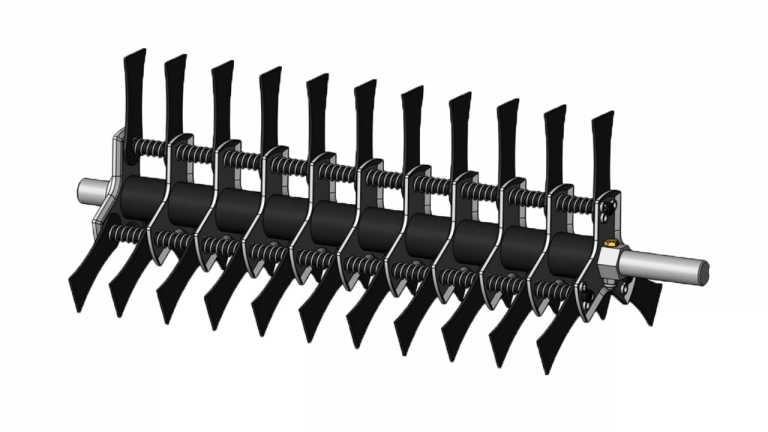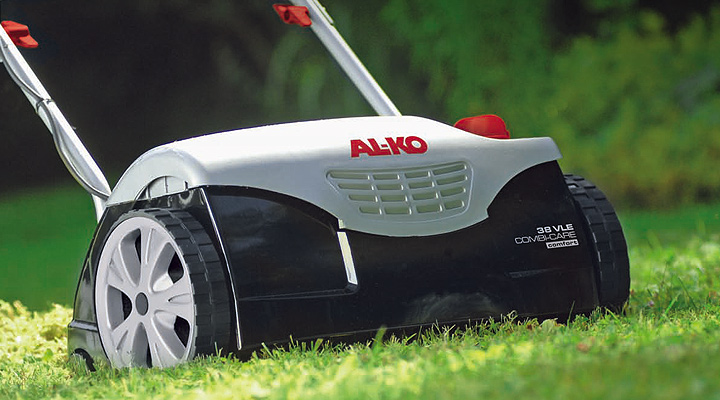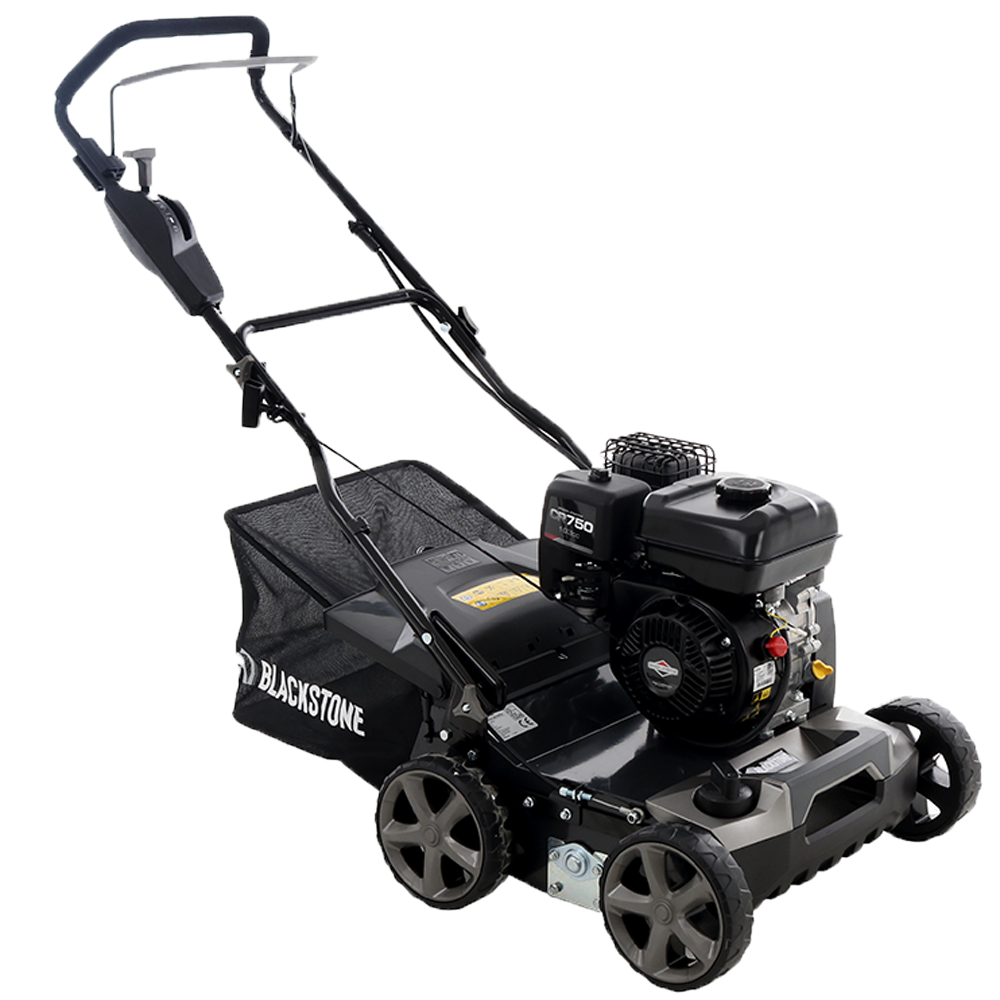The Complete Guide to help you choose the Best Lawn Scarifier – Raker
by the Real Experts of Gardening Equipment
The lawn scarifier is an extremely useful tool for garden care and cleaning, although sometimes underestimated. Experts know that a lawn scarifier is essential if you want to keep your lawn tidy and well-groomed. Choosing the best lawn raker is no easy task, but this purchasing guide will try to set you in the right direction towards the tool that best suits your needs.
CONTENTS
1. What is a lawn scarifier and what is it for?
The name “scarifier”, or “lawn aerator”, derives from the fact that it uses air to make the garden more lush. True aeration involves clearing the lawn from the layer of old matted grass (dead grass) that acts as a plug and prevents nutrients from entering the soil. The blade or spring of the lawn scarifier rips away old lawn debris and digs into the soil, thus drawing in water and nitrogen, the main nutrient for new lawn growth. We will discuss this process in more detail below.
The lawn raker is a practical and easy-to-operate tool. It is not, however, an ordinary gardening equipment: whoever choose it must be aware of the soil conditions to be cared for and the relative height of the machine from the ground. The lawn scarifier must be adjusted appropriately according to the working requirements, as operating the machine too low or at ground level on soil with stones or unevenness can lead to damage to the soil or the tool itself. It is generally equipped with a grass collection bag, which ensures easy and clean aeration work. The compact size of this tool means that it can be stored easily and takes up very little space.
But when should the lawn scarifier be used?
There are several types of lawn aerators, each of which may have different technical features and functions. In general, the lawn raker should be used when you want to keep your lawn clean and healthy.
The end of winter or the beginning of spring are the ideal times to aerate the lawn: this way, it is possible to remove moss and weeds that have formed during the winter and to allow the turf to breathe again so that it can flourish in spring.
It is important to use the lawn raker at the end of the season. At the end of autumn, the lawn is prepared, also for possible reseeding, to make it solid and strong during the winter and ready for the following season.
2. Lawn scarifiers with springs or blades

Aerating essentially means airing the lawn. The term lawn aerator is often combined, compared and confused with the term lawn scarifier. Scarifying is the removal of moss and dead grass.
It can be done with a spring or blade rotor and in both cases the aim is to remove old residues to make room for new growing grass.
WITH SPRINGS
The scarifying process is carried out using a rotor with springs. This type of aeration allows a meticulous, but rather superficial removal of moss and old matted grass.
The aeration carried out with a spring rotor, therefore, has a more gentle and superficial effect on the lawn by removing moss, matted grass, dry surface roots and old lawn residues.

WITH BLADES
The actual aeration takes place using the blade system, with which holes are made into the soil. This practice involves a less accurate removal of the matted grass, the rotor hoes are in fact further apart than the springs, but they work more deeply into the soil. With blades, it is possible to eradicate residues, which is simply not possible with spring scarifying.
With a lawn scarifier with blades, it is not only possible to remove old residues but also to pierce the soil, allowing water and nitrogen to penetrate more easily and effectively. The blades allow the roots to be thinned out so that the lawn can really breathe again.
3. Types of lawn scarifiers
There are different types of lawn scarifier, which are mainly divided according to the type of power unit they are equipped with. Which lawn scarifier to choose?
A brief mention should be made of manual lawn aerators: this is a tool similar to a large rake, sometimes with wheels on the sides for ease of use. Just like a rake, it is used manually and in order for it to penetrate the soil effectively and remove the matted grass, a certain amount of force must be applied by the operator.
3.1 Electric lawn scarifiers
The electric lawn scarifier is the ideal tool for aerating and scarifying a small to medium-sized lawn if you have an electrical outlet available. Electric lawn rakers are ideal for domestic and hobby work, but some models are also able to withstand more demanding and extensive operations, usually working on lawns of up to 1000 square metres.
The main feature of these lawn aerators is that they are maintenance-free, apart from the usual cleaning of the rotor after the lawn has been scarified.
Many models have an interchangeable rotor, with springs or blades, allowing a dual operation of simple scarifying and pure lawn aeration. The rotor with springs, the number of which varies depending on the model, scarifies the lawn, removing the layer of matted grass and moss that has formed and helps new grass to grow. The rotor with blades, on the other hand, is used for aeration: the blades dig holes into the ground, allowing the lawn to breathe, regenerate and oxygenate, facilitating the infiltration of water and the absorption of nutrients.
The right time for this operation is the spring season, that means after the very first lawn cutting operations and depending on the area and the climate conditions. For a perfect lawn care, it is highly recommended to repeat the operation even in the autumnal season in order to remove the hardest moss.
3.2 Petrol lawn scarifiers
The petrol lawn scarifier is ideal for medium to large lawns, up to a maximum of approximately 1400 square metres. It can be equipped with either Honda or Briggs & Stratton engines: two top quality brands that stand out for high performance and durability.
The most relevant factors when choosing these lawn aerators are the power delivered and the robustness of the machine. These tools usually feature a robust enamelled steel housing.
Most of them usually have an interchangeable rotor, with springs or blades, which allows for a dual operation of simple scarifying and pure lawn aeration. The rotor springs, the number of which varies depending on the model, scarifies the lawn, removing the layer of matted grass and moss that has formed and helps new grass to grow. The rotor with blades, on the other hand, is used for aeration: the blades dig holes into the ground, allowing the lawn to breathe, regenerate and oxygenate, facilitating the infiltration of water and the absorption of nutrients.
The right time for this operation is the spring season, that means after the very first lawn cutting operations and depending on the area and the climate conditions. For a perfect lawn care, it is highly recommended to repeat the operation even in the autumnal season in order to remove the hardest moss.
3.3 Heavy-duty lawn scarifiers with free-swinging blades
The lawn raker with free-swinging blades can be regarded as the best lawn scarifier. It is the heavy-duty version of this type of machinery for lawn aeration. Its petrol engine guarantees a high working autonomy and covers a surface area of up to 3000 square metres. The efficiency of lawn scarifiers with free-swinging blades is certainly superior to other types of lawn rakers.
Free-swinging blades consist of a fixed component, the part attached to the rotor, and a moving component that is held in place by the centrifugal force generated by the rotor. This technical solution improves the performance of the blades and thus the result of aeration: the lawn will be made ready to receive all the nutrients, nitrogen and oxygen it needs to grow thick and remain healthy.

This type of rotor with free-swinging blades is also ideal on hard, uneven ground with stones or clods of earth, as the movable blades can effectively cushion accidental impacts with material deposited on the lawn. This is because, due to their structure, these blades retract and absorb shocks while remaining intact. This means that work is never interrupted and there is no need to replace broken blades, as may be the case with fixed blades. The material quality of the blades is superior as they are made of high-strength hardened steel. They represent the distinguishing feature of the best lawn scarifier.
The right time for the scarifying work is the spring season, that means after the very first lawn cutting operations and depending on the area and the climate conditions. For a perfect lawn care, it is highly recommended to repeat the operation even in the autumnal season in order to remove the hardest moss. Please note that these machines do NOT perform soil milling work.
3.4 Towed lawn scarifiers for riding-on mowers
The towed lawn scarifier for riding-on mowers is a quite different tool compared to the tools described above. It can be considered a hybrid solution that can aerate the lawn, fertilise it and seed it at the same time. Towed lawn rakers are attached to a riding-on mower or ATV mowers. They are towed and therefore have no traction.
The aeration process carried out with these tools is less effective, but allows larger areas to be completed in a shorter time. The blades of the lawn raker act on the soil, digging holes through the weight of the tool itself.
These towed lawn aerators can also have multiple functions. For example, the lawn raker – fertiliser spreader aerates the soil by making cuts in the ground, at the same time allowing seeds and fertiliser to fall into these cuts. The tool is equipped with a basin in which the seeds are deposited and a lever that allows you to adjust the seeding rate from the comfort of your seat on the riding-on mower.
Towed lawn scarifiers with blades are ideal for hard, uneven ground. They are characterised by a very robust housing and blades, and also have a platform on which weights can be placed. Thanks to this configuration, the lawn aerator is be able to work deeper into the ground.
For flatter and more even ground, there are towed lawn rakers with springs that can remove moss from the lawn and dry residues that have accumulated over the winter. However, these too can have weights on the platform to counterbalance the usual lightweight construction of these tools.
4. How to aerate the lawn
In this purchasing guide we have learned that the main objective of scarifying is to remove matted grass from the soil. If the lawn to be cared for is often and regularly tended, and at least one aeration has been carried out in the last year, then an additional light aeration will suffice. If, on the other hand, the soil is not cared for on a regular basis, two or three aerations can be carried out; the garden clods can be left in the air to allow the lawn to breathe, they can be brought together by gently stepping on them.
After aeration, it is possible to sow seeds or apply herbicides.
Maintenance of the equipment is also important. The collection bag in which the matted grass is stored must be emptied, while the rotor and housing of the lawn scarifier must be cleaned after work. Thanks to its compact size, the lawn raker can be stored indoors to protect it from the weather.







